In the ever-evolving landscape of the modern workplace, the effect of AI on employment law emerges as a critical area of focus. Here we take an early look at the potentially complex interplay between rapidly advancing artificial intelligence technologies and the legal frameworks governing employment.
Changes in the Workforce
Job Displacement Concerns
The advent of artificial intelligence and automation has brought about significant shifts in the labor market, raising concerns about job displacement. This phenomenon isn’t just limited to traditionally manual roles. Sophisticated AI systems increasingly encroach on tasks once performed exclusively by humans.
For employment law, this technological upheaval presents unique challenges. Historically built around human workers, regulatory schemes are now facing the complex task of adapting to scenarios where machines can perform similar functions. The key legal issue here is determining the extent of employer responsibility in mitigating the impact of such displacements. This endeavor includes examining existing laws on layoffs and workforce restructuring to ensure they are equipped to handle the nuances of AI-induced job displacement. It’s not just about the loss of jobs, but also about the fairness and legality of the process leading to such workforce changes.
Integrating AI in the workplace raises questions about the nature of work itself and the definitions that employment law has long relied upon. For instance, if an AI system can perform tasks that once required a team of employees, what does this mean for those employees’ contracts, their job security, and their legal rights? This transition phase is critical; laws governing layoffs, severance, and unemployment benefits will come under scrutiny to ensure they adequately address these new realities. Employers must navigate these legal waters carefully, balancing the efficiency gains from AI with the legal and practical implications of their workforce decisions. They must consider the legal consequences of reclassifying or terminating positions due to automation and the costs vs. benefits of providing support, such as retraining or severance packages, to those affected.
The emotional and social impact of AI-induced job displacement also cannot be overlooked. While employment law primarily focuses on the legal and financial aspects of job loss, there’s a growing recognition of the need to address the psychological effects on displaced workers. This aspect is increasingly being scrutinized as a component of corporate social responsibility. Employers are being called upon not only to comply with the legalities of workforce restructuring but also to consider the broader human impact of their decisions. Companies may be increasingly expected to provide career counseling, mental health support, and transitional assistance as part of severance packages. The future of employment law in this area may see a more holistic approach, where the legal responsibilities of employers extend beyond mere financial compensation, encompassing a duty to aid in the well-being of their former employees during times of transition.
Emergence of New Job Categories
As AI reshapes the workforce landscape, it is displacing traditional roles and paving the way for new job categories. This evolution is birthing diverse positions that didn’t exist a decade ago, such as AI ethics compliance officers, robot coordinators, and data privacy managers. These roles are critical components in the modern business environment, bridging the gap between rapidly advancing technology and existing business structures. From an employment law perspective, the challenge lies in categorizing these new roles within the existing legal environment. Traditional employment classifications may not be apt for these novel positions, which often blend elements of technology, ethics, and management. Human resources professionals may need to reevaluate job classification criteria, benefits allocation, and labor standards to ensure they are inclusive of these new roles while safeguarding employee rights and interests.
The advent of these new job categories also raises questions about the skills and qualifications required, which in turn implicate hiring practices and employment contracts. Employers must navigate a landscape where job descriptions constantly evolve and require more highly specialized skills. Employment contracts for these roles might need to be more flexible and dynamic, reflecting the ongoing development and shifting responsibilities within these positions. A legal balancing act will be necessary to ensure that contracts are sufficiently specific to protect employer and employee interests while also being adaptable to the evolving nature of the work.
Additionally, there is the legal consideration of equal opportunity in hiring for these new roles. As these positions often require specialized skills and knowledge, there’s a risk of inadvertently excluding qualified candidates due to biases or unrealistic qualification expectations, which could lead to legal challenges based on discrimination laws.
Implications for Employment Contracts and Policies
Contractual Changes for AI-driven Roles
Integrating AI in the workplace may lead to a significant rethinking of employment contracts, particularly for roles directly influenced or augmented by these technologies. In AI-driven roles, where employees work alongside or are assisted by AI systems, job descriptions and responsibilities are no longer static but evolve as the technology evolves. Employment contracts must reflect this fluidity to ensure they remain relevant and enforceable. Employers must draft sufficiently flexible agreements to accommodate changes in job roles without compromising the clarity and enforceability of the terms. The agreement may include clauses that detail how job roles may change over time, processes for regular review and updating of job descriptions, and clear communication channels for employees to discuss and understand these changes. From a legal perspective, the challenge is balancing flexibility and specificity to protect both the employer’s operational needs and the employee’s job security and rights.
Performance metrics in AI-driven roles present a unique challenge. Traditional methods may not be suitable when employees work with artificial intelligence tools that significantly enhance their productivity or decision-making. Employers must develop new metrics assessing human contributions in a technologically augmented environment. This exercise requires careful consideration to ensure that employees are evaluated based on their skills, decision-making, and management of AI tools rather than purely on output, which the AI’s capabilities could heavily influence. Legally, this is a delicate area as it ties into compensation, promotions, and even termination decisions. Employment contracts or applicable policies may need to reflect how performance will be measured and rewarded in this context, and any performance-based incentives must be designed to account for the AI’s role in the employee’s work.
As machine learning and automation continue to advance, employees must keep their skills up to date to remain effective in their roles. Employment contracts might increasingly include ongoing training and professional development provisions, outlining the employer’s commitment to providing these opportunities and the employee’s responsibility to engage with them. This approach not only ensures that employees remain competent and competitive in an AI-augmented workplace, but also highlights the employer’s commitment to their workforce’s growth and adaptability. With or without new legal imperatives, new standards for how employers support employee development may result.
Intellectual Property and Data Privacy
The surge in AI-driven roles brings critical legal issues surrounding intellectual property (IP) and data security to the fore. In work environments heavily integrated with AI, a significant question arises: Who owns the IP created by AI tools, especially when they’re used by employees in their work? This question extends beyond traditional IP norms, as AI systems can create, innovate, or even make decisions autonomously. Employment contracts should clearly address the ownership of IP generated with the aid of AI. The challenge lies in drafting contract terms that fairly attribute IP rights between the employer, the employee, and potentially even third parties involved in providing or maintaining the AI systems. Laws also need to evolve in recognizing AI’s role in creation and innovation, potentially leading to new categories of IP rights and responsibilities.
Data security is another paramount concern in AI-integrated roles. Employees increasingly handle sensitive data with the assistance of AI tools, heightening the risks of data breaches or misuse. Employment contracts should include stringent data protection clauses, clearly outlining the employee’s responsibilities in safeguarding data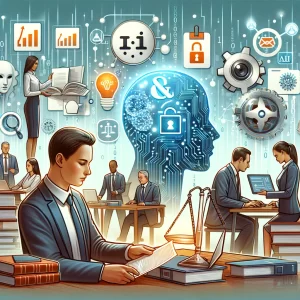
In an era where AI-driven decision-making is becoming increasingly prevalent, there is a growing need to address the legal implications of decisions made or influenced by AI in the workplace. Employment contracts (or employee policies) may need to reflect the extent to which AI recommendations or analyses can be relied upon for making critical decisions, such as those related to hiring, performance evaluations, promotions, or even terminations. The legal challenge is to ensure that AI’s role in such decisions is transparent and that there are mechanisms for human oversight and accountability. To comply with applicable employment laws, employers must establish clear guidelines on using AI in decision-making processes.
Wages and Working Hours
Wage Structure Adjustments
Implementing AI in the workplace may have profound implications for wage structures, a development that demands careful legal and practical consideration. As AI and robotics enhance productivity and efficiency, they invariably alter the value and nature of human labor, which in turn should be reflected in wage structures. One of the key legal challenges here is ensuring that wage adjustments due to AI integration are fair and non-discriminatory. For instance, roles that become more technical or supervisory due to AI might warrant higher wages, whereas positions with reduced responsibilities could see wage stagnation or even reductions. This shift necessitates a reevaluation of job classifications and corresponding pay scales to ensure they align with the new realities of AI-enhanced work. Employment laws and regulations may need to address how employers can implement wage changes without discriminating against certain groups of employees.
The changing wage structures due to AI and automation also highlight the need for policies that support ongoing skill development. As the value of specific skills increases and others decrease, there is a legal and practical imperative for employers to facilitate and potentially finance the upskilling of their workforce. Doing so could both aid employees in adapting to new roles or enhanced responsibilities and help mitigate the broader societal impacts of technological displacement. Legislation may increasingly focus on incentivizing or mandating employer-led training initiatives, ensuring the workforce can transition smoothly in an AI-driven economy. New wage models may develop where compensation is linked not just to output or hours worked, but also to ongoing skill development and adaptation in the face of rapid technological change.
Working Hours and Overtime
AI will also impact working hours and overtime regulations. One of the primary legal challenges in this realm is defining and regulating working hours in jobs where AI tools significantly increase productivity. But it may also further blur the lines between traditional work hours and overtime for many roles, as these technologies can enable continuous operation beyond the standard workday. This raises questions about fairly compensating employees who oversee, maintain, or interact with AI systems outside of regular working hours (or who have no fixed hours). Employment law must evolve to address these new scenarios, potentially requiring updates to overtime regulations to ensure that employees are justly compensated for the time they engage with or oversee AI-driven processes, even if the physical effort or traditional work hours are reduced, without penalizing employers with further expense due to overtime obligations.
In this respect, using artificial intelligence presents an opportunity to rethink the balance between work and personal life. There’s potential for these technologies to reduce the need for overtime by increasing efficiency during regular working hours. However, this benefit must be balanced against the risk of infringing on employees’ personal time. Employment law can play a critical role here, setting boundaries to protect employees from being constantly “on call” due to the pervasive nature of AI technologies. Regulations may be implemented to establish guidelines on the right to disconnect, limiting employers’ flexibility in deploying both their staff and technological resources.
AI Bias and Discrimination
The deployment of artificial intelligence in employment processes, such as recruiting, hiring, and promotions, has introduced complex challenges regarding bias and discrimination. Despite the objective façade of AI systems, they are vulnerable to ingraining and perpetuating biases in their training data or algorithms. This inadvertent bias can lead to discriminatory practices in employment decisions, raising significant legal concerns under existing employment discrimination laws. For instance, if an AI hiring tool disproportionately screens out candidates from a particular demographic group, it could violate equal employment opportunity laws. Legal scrutiny increasingly focuses on how employers can best ensure their AI tools aren’t biased in favor of specific discriminatory outcomes. This requires a proactive approach in regularly auditing and reviewing AI systems for fairness and bias and an inevitable application of employment laws that hold employers accountable for the discriminatory impacts of their AI tools, intentional or not.
Employment laws will likely evolve to include guidelines and standards for developing and using AI in employment practices. This could involve mandating transparency in AI decision-making processes, requiring employers to disclose the use of AI in their employment decisions, and allowing candidates and employees to challenge decisions they believe were influenced by biased AI.
Accordingly, there is an emerging need for collaboration between technologists, legal experts, and policymakers to address the issue of AI bias in employment. Developing AI that is both effective and unbiased requires a multidisciplinary approach, combining technical expertise with an understanding of social and legal implications. Future legal requirements might encourage or even demand this collaborative approach in developing and deploying AI systems in employment contexts. These frameworks could also promote ongoing education and training for employers and HR professionals about the risks and responsibilities of using AI in employment decisions.
Laws and regulations may require rigorous testing for bias before AI systems can be implemented in critical employment processes like hiring, promotions, or terminations. Continuous monitoring and auditing of these systems will be expected in order to ensure they remain unbiased over time.
Safety in AI-Integrated Workplaces
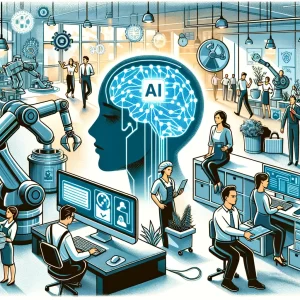
Thus far, the unpredictability of AI and automated systems poses a significant challenge in maintaining workplace safety. Unlike traditional machinery, AI-driven systems can learn and adapt over time, potentially leading to unforeseen operational behaviors. This requires a dynamic approach to safety management, where safety measures are regularly reviewed and updated in response to changes in the AI system’s behavior or capabilities.
The psychological safety of employees working with AI is also an important consideration. Introducing AI in the workplace can create anxiety and stress among employees, particularly if they are concerned about job security or are unaccustomed to interacting with advanced technology. Employers may need to provide counseling services, offer training programs to build familiarity and comfort with AI technologies, and create channels for employees to express their concerns and feedback about AI integration.
The remote and often isolated working conditions that AI-enabled technologies facilitate pose additional mental health challenges. Ensuring employees working remotely with AI tools have access to the same mental health and well-being resources as in-office employees is essential.
Collective Bargaining in the AI Era
The rise of AI in the workplace presents new challenges and dynamics in collective bargaining. As AI continues to change the nature of work, collective bargaining may also need to evolve. One of the primary concerns is the impact of AI on job roles and employment terms. Unions are increasingly seeking to negotiate aspects of AI implementation, such as retraining programs, job reclassification, and the potential displacement of workers. Employers should engage in more complex and forward-looking negotiations, taking into account the long-term implications of AI on the workforce.
The introduction of AI in the workplace opens up new areas for negotiation between employers and unions. Issues such as data privacy, surveillance, and the use of AI in employee monitoring and performance evaluations are becoming increasingly relevant. Unions will likely advocate for strict guidelines and limitations on how employers can use AI to monitor and evaluate workers. Labor and employment laws and regulations may begin to address these emerging concerns by establishing new boundaries and protections regarding the use of AI in employee monitoring and evaluation. This could include legal requirements for transparency, consent, and limits on the scope and use of AI-driven employee data collection.
Employee Rights and AI Supervision
The increasing use of AI for supervisory functions in the workplace raises essential considerations regarding employee relations. AI systems, capable of monitoring performance, managing tasks, or even making disciplinary decisions, present a new frontier where the traditional boundaries of supervision are being redefined.
One primary concern is how AI can be involved in decision-making processes that affect employees’ careers, such as evaluations, promotions, or terminations. Employment laws will increasingly address the transparency and fairness of AI-driven decisions, ensuring that employees have the right to understand how decisions are made and to appeal against decisions that they believe are unjust.
Another aspect that will draw attention is the impact of AI supervision on workplace privacy and autonomy. AI systems used for monitoring employee performance or behavior can be seen as infringing on personal privacy, leading to a work environment perceived as intrusive and controlling. This not only raises legal concerns about privacy rights, but also has implications for employee morale and trust.
Finally, using AI in supervision requires reevaluating the legal definition of “supervisor” and the associated responsibilities and liabilities. Traditionally, supervisors are individuals who carry certain legal duties, including compliance with labor laws and workplace regulations. When AI systems take on supervisory roles, it raises the question of accountability, particularly when AI-driven decisions lead to legal disputes or infringements of employee rights. Employment law will develop to determine liability in cases where AI is involved in supervision, potentially holding employers accountable for the actions of their AI systems. Furthermore, this shift calls for training and education for employees and human supervisors on interacting with and responding to AI in supervisory roles, ensuring legally compliant integration of AI into the fabric of workplace management.
Making AI Work
Workplace AI heralds a transformative era in employment law. The legal landscape will evolve in response to technological advancements. But it’s never clear how well the laws will keep up with the realities of the workforce.
This transition requires a delicate balance between embracing AI’s efficiencies and preserving the workforce’s rights and well-being. Policymakers, legal experts, and business leaders are crucial in navigating this transition. Collaborative efforts are necessary to develop comprehensive legal standards and guidelines that cater to the nuances of AI in the workplace. Continuous dialogue between these stakeholders, with input from employees and unions, will be vital in shaping forward-looking laws grounded in the reality of the workplace. It’s not just about mitigating the challenges; it’s also about leveraging the opportunities AI presents to create a more dynamic workforce.
Employers, employees, and legal professionals must remain vigilant and adaptable, ready to respond to the ever-evolving relationship between AI, automation, and employment law. By doing so, we can facilitate the integration of AI into our workplaces not as a disruptive force, but as a harmonious and beneficial evolution. The journey ahead is complex, but with thoughtful and concerted efforts, the legal landscape can reasonably accommodate AI in the world of work.
For more employment law analysis and updates, sign up for the Horton Management Law email newsletter and follow us on LinkedIn.
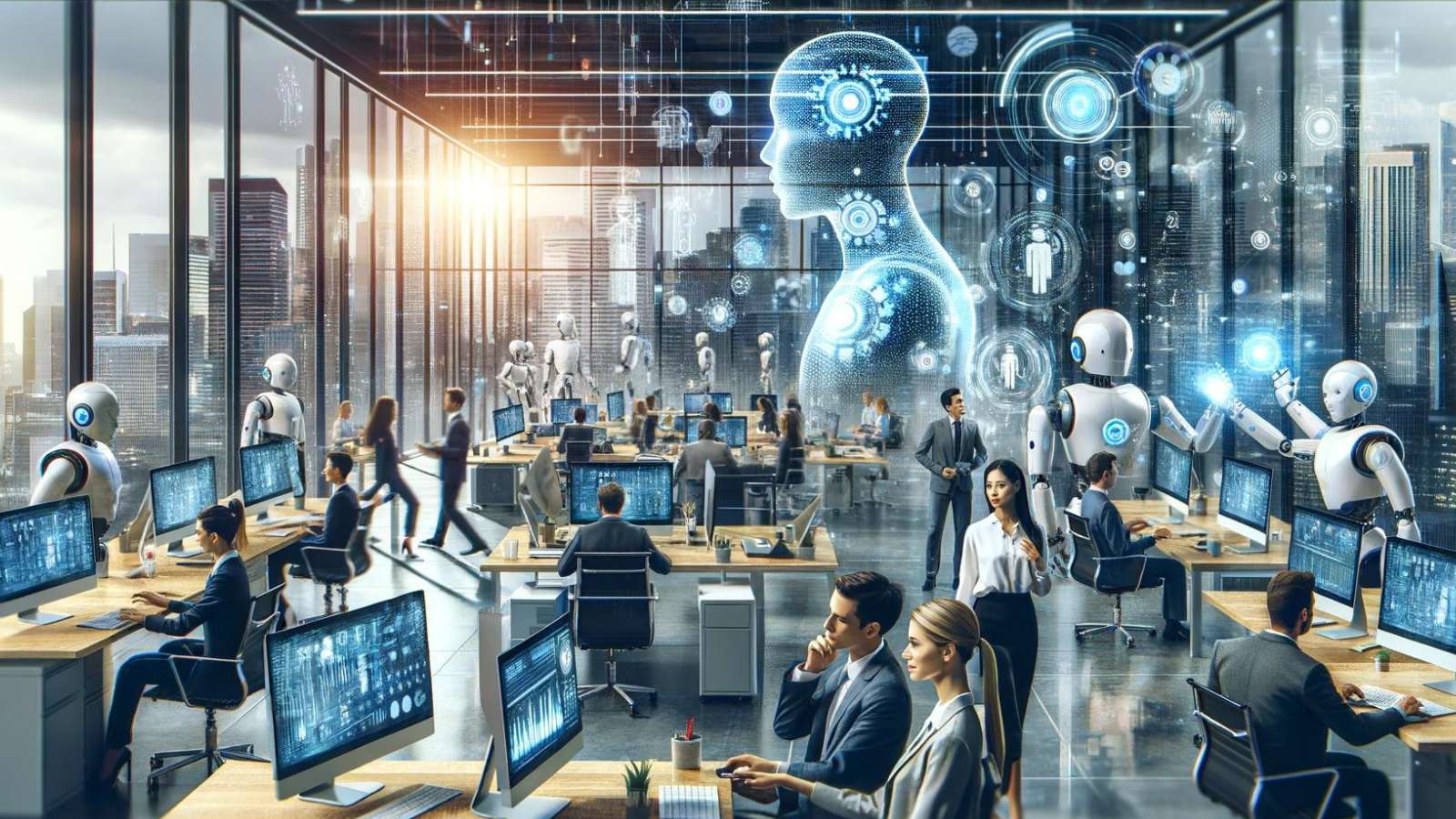
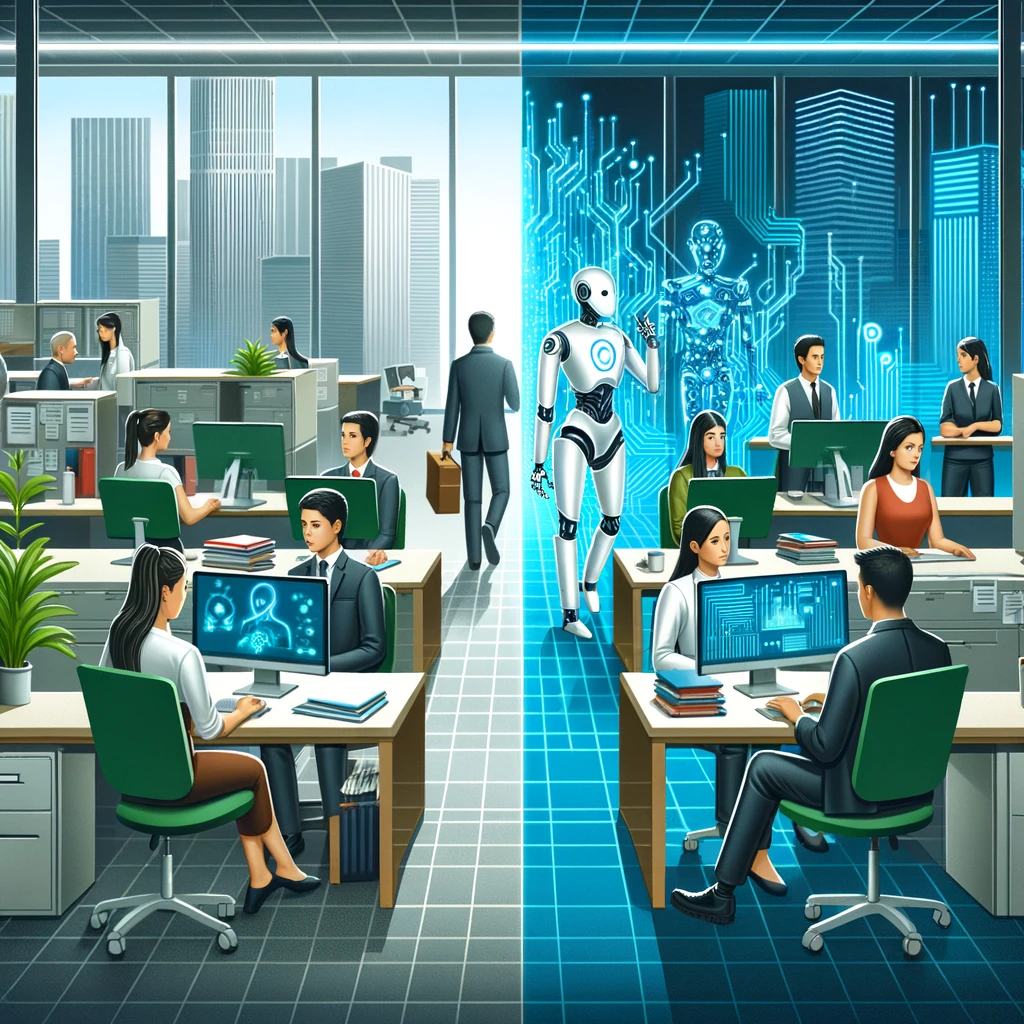
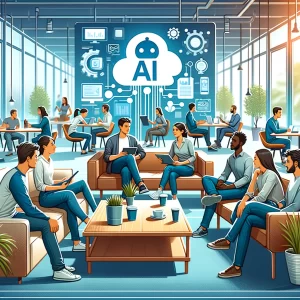
You must be logged in to post a comment.